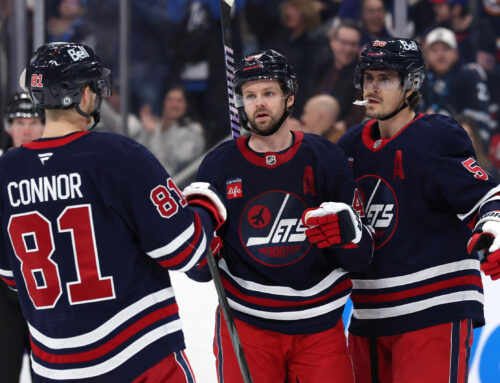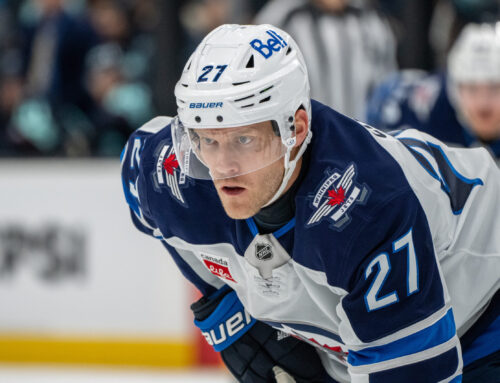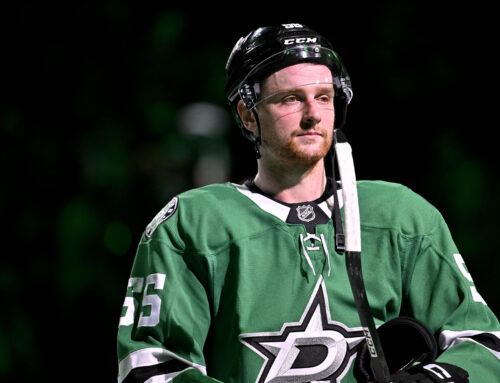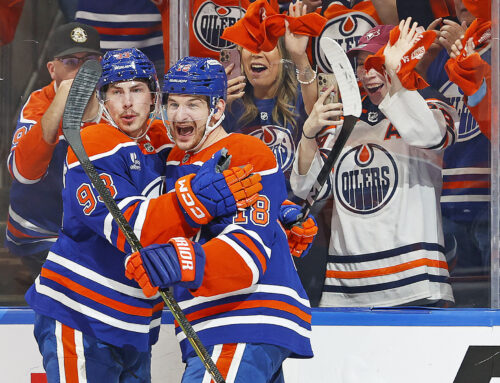
While there is no consensus “best” rookie hitting the NHL West as we enter training camp, several have great chances of landing starring roles that could accelerate franchise turnarounds. Particularly among forwards Arizona, Vancouver and Colorado can take great strides if their best young prospects meet success. Here are a few, along with others that look to contribute substantially this year for recently more victorious organizations.
Forwards
Clayton Keller, Arizona Coyotes
As we already knew and confirmed in flashes during the waning days of the 2016-17 schedule, Clayton Keller will score many points for many seasons. Looking a year or two younger than his 18 years during that three-game stint, Keller infused a bedraggled Coyotes club with new life. He’ll take that to another level next year, I’m betting as a second line left wing with significant power play minutes. With the additions of Derek Stepan, perhaps Dylan Strome taking the next step, and further development of Max Domi, Brendan Perlini, Christian Dvorak and a host of other forwards along with a healthy and revitalized Oliver Ekman-Larsson there should be more goals to go around than 191, Arizona’s total last year and fourth worst in the league. I’ll say he reaches the 50-point neighborhood with about 25 goals and 25 assists. Considering last year’s club saw only one skater register more than 40 points, new Panther Radim Vrbata with 55, that’s very solid.
Joel Eriksson Ek, Minnesota Wild
Eriksson Ek has proven he’s NHL ready, excelling on defense and racking up three goals and four assists in 15 Minnesota contests. And that’s while averaging only 10:37 minutes per contest. After the departure of centers Martin Hanzal and Erik Haula, and in spite of their recent Matt Cullen signing, the Wild seem to have one more center job up for grabs. With a slew of versatile forwards capable of playing on the right, left or at the pivot, Eriksson Ek may slot into the third center spot with last season’s second-highest scoring squad. That’s a line speculated to feature plenty of muscle with Marcus Foligno (whose 279 hits ranked 5th in the NHL last year) and playmaking potential with Charlie Coyle whose scoring total reached a career-high 56 points, including 38 assists, in 2016-17. If that arrangement doesn’t manifest, there are many other distributors and shot-takers to potentially help Eriksson Ek register impressive point totals. While he may not maintain last year’s 20.0% shot rate, he has a golden opportunity to shine in his first extensive experience outside of Sweden.
Kyle Connor, Winnipeg Jets
It’s not likely, but if frighteningly quick left wing Connor can sneak onto one of the Jets’ dangerous top lines he could do some serious damage. His best shot to do so might be beating out established Mathieu Perreault who saw a 17-point hot streak in his final 12 contests. That could be difficult. Whether it happens sooner or later, Winnipeg’s 2015 first round pick has the talent to excel alongside Scheifele, Wheeler, Laine, Little and/or Ehlers. Unlike many speedsters Connor sports a solid two-way game to go with a 71-point, 38-game final NCAA campaign in 2015-16, and 44 points at AHL Manitoba in 52 contests last year. He wasn’t spectacular in a 20-game Winnipeg stint (two goals, three assists) coming straight to the NHL from college to begin 2016-17, but redeemed himself with a particularly hot second half skating for the Moose.
Brock Boeser, Vancouver Canucks
In a bleak 2016-17 campaign Boeser offered hope to Vancouver faithful, registering four goals and an assist as he joined the Canucks for a nine-game end-of-year stint. He connected well on the Horvat – Baertschi line, as well as with the Sedins on the power play, and the money bet is he’ll man those spots again on opening night. His smart, hard-working, well-rounded game is vital as Vancouver seeks resurgence. I’m not sure there’s any way other than injury Boeser will avoid starting the in their top six. At each level – USHL, NCAA, even in high school he’s registered nearly equal goal and assist totals, so expect him to rack up respectable totals in each column with the major restraint being Vancouver’s ability to score sufficiently. If Boeser lands anywhere near the 43 goals and 51 assists he totaled in 74 NCAA contests most of southern BC will rejoice. Despite the additions of Gagner, Del Zotto and Burmistrov, and Derek Dorsett’s return from injury, Vancouver’s skaters haven’t significantly upgraded over last year’s squad that topped only Colorado in goals scored.
Tyson Jost, Colorado Avalanche
Jost got his NHL feet wet at the end of Colorado’s horrid 2016-17 landing a goal and assist in six contests paired most frequently with Landeskog and Grimaldi. He has great scoring potential and energy that translates into gritty, speedy play, but like former North Dakota teammate Boeser surrounded by an even more meager offense, Jost will have trouble duplicating the point-per-game pace he maintained as an 18-year-old in his lone NCAA campaign (16 goals, 19 assists in 33 contests). While a long-rumored Matt Duchene deal could move Jost up the org chart, expect Jost to center the third Avalanche line and serve on their second power play unit. He’s a cornerstone for the future, and should produce reasonably well between Colin Wilson and perhaps Nail Yakupov, but without a stronger supporting cast I’m not sure he’s a Calder finalist.
Dylan Strome, Arizona Coyotes
Strome obliterated the OHL with 114 goals and 240 assists over his past four campaigns and 219 Erie Otter games. At only age 20, there’s growing impatience for him to cause some of that danger in the NHL. Many expect this is the year, particularly with Keller’s widely-expected emergence and a slew of other prospects the club hopes starts to hit now. Like Jost, centering the third line seems his entry point into 2017-18. Like Keller, he’s working for one of last year’s lowest-scoring squads, but upgrades might make this year’s scoring environment more conductive to Strome thriving. Last year’s seven-game Coyotes’ stint out of training camp didn’t feature quite that quality, and Strome’s stats followed suit with just one assist in seven contests skating predominantly with Jamie McGinn and Anthony Duclair leading off a disappointing campaign. This year he looks to center a line with perhaps Tobias Reider and Christian Fischer, but with abundant rising prospects and new veteran additions it’s tough to accurately guess line combinations.
Defensemen
Julius Honka, Dallas Stars
In a somewhat thin year for quality Western Conference-ready blue line rookies 21-year-old Honka stands out. He may emerge a little later than many expected. An upper-body injury hampered the 5-10, 185-pound, third-year pro forcing him to spend much of 2016-17 with AHL Texas when he appeared an NHL breakout candidate. He’s proven a capable scorer there with 26 goals and 80 assists in 191 contests, and added a goal and four assists with 34 shots in 16 Dallas contests. Expect a regular third pairing NHL gig at minimum in 2017-18, along with decent power play minutes. Playing on a much-maligned Dallas defense, Honka registered excellent possession numbers with a CF% rel of 7.3 and overall CF% of 56.4. He added nearly a block-per-game as well with 15 in just under 17 minutes per-game.
Jake Walman, St. Louis Blues
Vince Dunn, Jordan Schmaltz and Walman all project bright futures behind an already strong Blues’ blue line, but Walman seems closest to making an NHL difference despite just seven regular and eight postseason games of professional experience, all with AHL Chicago last year after wrapping up his NCAA three-year career at Providence (21 goals, 48 assists, in 107 contests). Walman is a determined and speedy, left-shot sniper working hard to add muscle to his game. Since drafted by St. Louis in 2014 he’s gained about 30 pounds and increased his toughness and defensive presence. He’s a good candidate to eventually quarterback the power play, and if he can wrest a third-pairing NHL role out of camp from several veterans and garner significant minutes there’s a good chance he’ll develop quickly.
Paul LaDue, Los Angeles Kings
Grand Forks native LaDue parlayed a 22-game run with Los Angeles into a potential 2017-18 second pairing to Alec Martinez’ right, assuming some of Brayden McNabb’s expansion-departed minutes. He’s less a scoring demon, and more a solid blue line component that fits well with the Kings’ recent defensive philosophy. LaDue’s 2.7 CF% rel on LA’s effective defensive unit, along with a 57.0 CF% speak well for his possession skill, as do his 17 hits and 13 blocks which should increase with further NHL experience and minutes (just 15.24 average TOI last year). He can even lend experience, as LaDue turns 25 years old shortly and won a NCAA championship with North Dakota in 2016. In three years of college LaDue averaged just over half a point-per-game with 62 in 123 contests, so he won’t be lost on offense.
Goalies
Juuse Saros, Nashville Predators
In spite of his mostly fantastic postseason performance last year and a pretty decent campaign overall, Pekka Rinne’s effectiveness has diminished since a stellar 2014-15 campaign. If the soon 35-year-old vet slips further, backup Juuse Saros has loads of promise that fellow Finn Rinne is helping to mentor. The plan seems that he’ll gradually transition from backup to at least 1B status as Rinne approaches UFA status in 2019, but expect the 22-year-old, whose 21 games last year just barely keep him at the NHL rookie requirements, to progress. His 10-8-3, 2.35, .923 line last year shows he might almost be ready.
Thatcher Demko – Vancouver
While Jacob Markstrom appears number one in net to start the Canucks’ year and Anders Nilsson was signed as the backup, neither has a sizable or impressive record of success. Uber prospect Thatcher Demko is waiting in the wings for opportunity in Vancouver to arise. If not on a grand scale this year, the 21-year-old Demko will be something special before long. With new Head Coach Travis Green promoted from their AHL affiliate in Utica and very familiar with Demko, expect the young Canuck to get some ice time in 2017-18. It’s not out of the question he’ll end up the starter at some point in the upcoming campaign.
Follow me on Twitter @KWcrosscheck
2 Comments
Leave A Comment
You must be logged in to post a comment.





 CAR
CAR WPG
WPG PHI
PHI ANA
ANA BUF
BUF CHI
CHI COL
COL T.B
T.B
 L.A
L.A

The Coyotes might be wise to give Strome a season in the AHL before making the leap when they already have enough capable C in the lineup this year. Having Stepan gives them the option to let him mature.
I’m a fan of Honka, and I think he’ll be fairly productive, but playing for Hitch might prove difficult if he’s not a fan of his defensive play.
I have Keller playing as the #1 RW. Here is what I have for Arizona so far. Shuffle the wingers anyway you like. I have Domi at LW with Stepan but he looked great on a line with Dvorak & Vrbata until Vrbata was traded.
Domi/Perlini, Stepan, Keller.
Perlini/Domi, Dvorak, Duclair/Reider.
Martinook, Strome, Reider/Duclair.
Crouse, Cousins, Richardson.
McGinn.